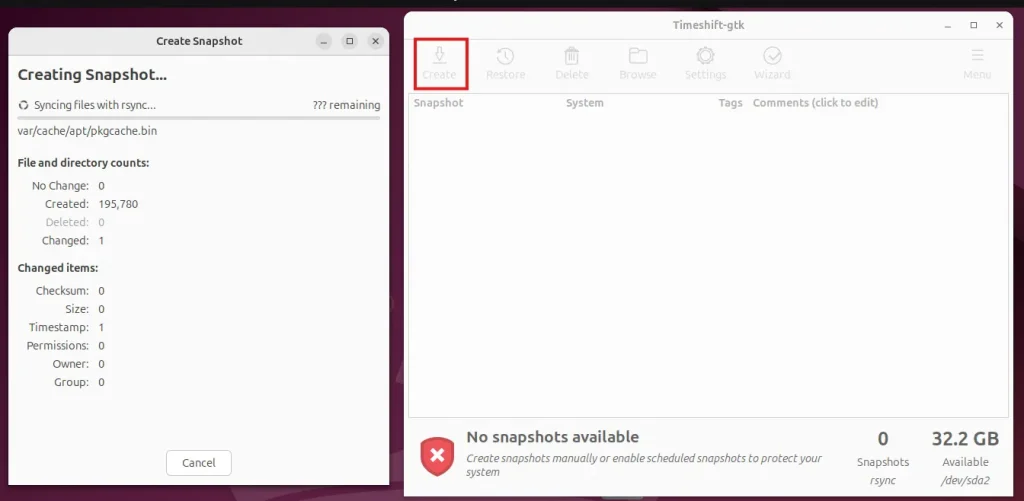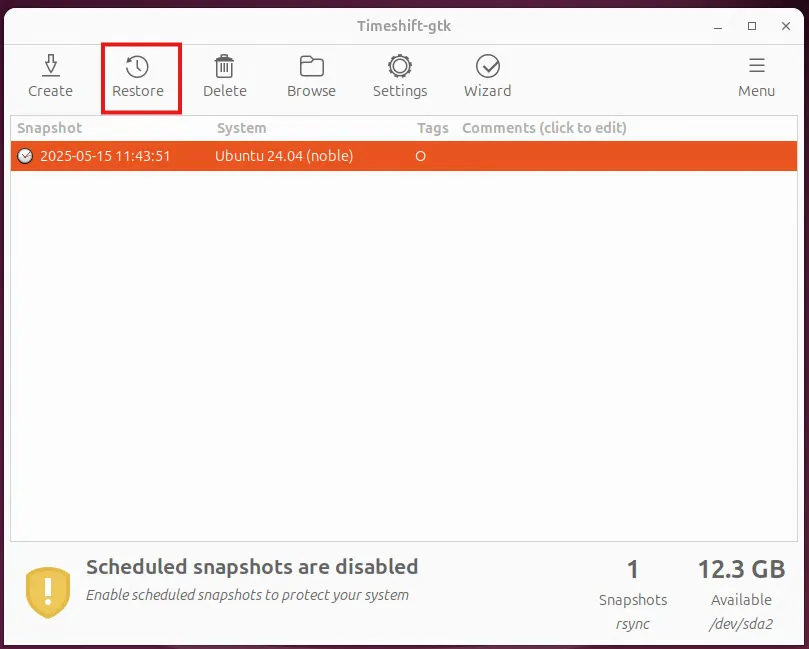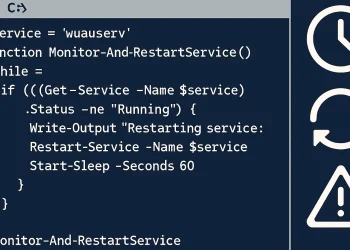About Timeshift
Timeshift Linux snapshots are essential for maintaining a stable and recoverable Linux environment. Whether you’re experimenting with new software or performing system updates, one mistake can potentially break your system.
Timeshift is a powerful tool for Linux users that allows you to take snapshots of your system and easily restore them if something goes wrong. It works similarly to Windows’ System Restore and provides peace of mind without the need to manually manage backups.
Prerequisites
Before using Timeshift, make sure your system meets the following requirements:
- A Debian/Ubuntu-based distribution (Timeshift also supports Arch and derivatives)
- Administrative (sudo) privileges
- Available storage space on your system or an external disk for snapshots
- Timeshift installed (can be installed via APT or the software center)
To install Timeshift on Ubuntu/Debian:
sudo apt update
sudo apt install timeshiftBenefits and Negatives of Timeshift Linux Snapshots
Benefits
- Quick system recovery: Restore your OS to a previous state within minutes.
- Non-destructive backups: User files (by default) are not affected unless you choose to include them.
- Automated snapshot scheduling: Daily, weekly, or monthly backups.
- Simple graphical and CLI interface.
Negatives
- Does not “back up” user data by default (only system files unless manually configured).
- Can consume a lot of disk space, especially with RSYNC-based snapshots.
- Not a full substitute for complete system backup (e.g., it doesn’t back up
/homeunless configured).
Initial Setup of Timeshift on Linux
- Snapshot type: Choose between RSYNC or BTRFS.
- RSYNC is suitable for most users.
- BTRFS is available only on BTRFS-formatted systems with subvolumes.
- Select snapshot location: Pick a drive/partition with enough space.
- Snapshot schedule: Configure automatic snapshots (daily, weekly, monthly).
- User file exclusion/inclusion: By default, Timeshift only backs up system files (not
/home). You can include it in settings if desired.
Create a Snapshot
To manually create a snapshot:
Graphical Interface (GUI)
- Open Timeshift with
sudoprivileges. - Click the “Create” button.
- Wait for the process to finish. You’ll see the snapshot listed with the date and time.

Command Line Interface (CLI)
sudo timeshift --create --comments "Before software installation"Troubleshooting: No space left on device
If you encounter the error “No space left on device”, it likely means Timeshift is trying to save snapshots to a partition with insufficient space. To fix this, you can change the snapshot location to a different partition with more free space.
user@2nd-server:~$ sudo timeshift --create --comments "Before software installation"
First run mode (config file not found)
Selected default snapshot type: RSYNC
Mounted '/dev/sda2' at '/run/timeshift/4822/backup'
Selected default snapshot device: /dev/sda2
------------------------------------------------------------------------------
Estimating system size...
Creating new snapshot...(RSYNC)
Saving to device: /dev/sda2, mounted at path: /run/timeshift/4822/backup
Syncing files with rsync...
E: Error writing to file: No space left on device
E: Failed to write file: /run/timeshift/4822/backup/timeshift/snapshots/2025-05-15_09-44-05/rsync-log-changes
E: rsync returned an error
E: Failed to create new snapshot
Failed to create snapshot
------------------------------------------------------------------------------
Removing snapshots (incomplete):
------------------------------------------------------------------------------
Removing '2025-05-15_09-44-05'...
Removed '2025-05-15_09-44-05'
------------------------------------------------------------------------------
IMPORTANT: Store Snapshots on a Separate Partition or Disk
- Avoid saving snapshots on
/boot,/home, or the same root partition if space is limited. - Ideally, use a separate disk, LVM volume, or large partition with at least:
- 20–30 GB free for normal snapshots.
Step 1: Check where you have the space, in my case it is on the /dev/mapper/ubuntu--vg-ubuntu--lv
user@2nd-server:~$ df -h
Filesystem Size Used Avail Use% Mounted on
tmpfs 785M 1.2M 784M 1% /run
/dev/mapper/ubuntu--vg-ubuntu--lv 47G 8.9G 36G 20% /
tmpfs 3.9G 0 3.9G 0% /dev/shm
tmpfs 5.0M 0 5.0M 0% /run/lock
/dev/sda2 2.0G 97M 1.7G 6% /boot
tmpfs 785M 12K 785M 1% /run/user/1000
Step 2: Change Snapshot Location
To configure Timeshift to use this location via CLI, run:
sudo timeshift --snapshot-device /dev/mapper/ubuntu--vg-ubuntu--lvOutput:
App config loaded: /etc/timeshift/timeshift.json
Mounted '/dev/dm-0 (sda3)' at '/run/timeshift/5193/backup'
App config saved: /etc/timeshift/timeshift.jsonCheck the Timeshift Configuration
- Check Disk Usage and Choose a Storage Location for the Snapshots
user@2nd-server:~$ df -h
Filesystem Size Used Avail Use% Mounted on
tmpfs 785M 1.2M 784M 1% /run
/dev/mapper/ubuntu--vg-ubuntu--lv 47G 14G 31G 31% /
tmpfs 3.9G 0 3.9G 0% /dev/shm
tmpfs 5.0M 0 5.0M 0% /run/lock
/dev/sda2 2.0G 97M 1.7G 6% /boot
tmpfs 785M 12K 785M 1% /run/user/1000- Ceheck Device UUID for Location
/dev/mapper/ubuntu--vg-ubuntu--lv
user@2nd-server:~$ sudo blkid
/dev/mapper/ubuntu--vg-ubuntu--lv: UUID="e013cba3-a33a-4def-afe0-41df1cc1e6d8" BLOCK_SIZE="4096" TYPE="ext4"
/dev/sda2: UUID="51b9ea97-d3a0-43aa-886e-482392a8c724" BLOCK_SIZE="4096" TYPE="ext4" PARTUUID="3d865301-bb38-4e2c-8a17-81b0e954698f"
/dev/sda3: UUID="YY3s1l-IVE3-5A2C-XUie-lmRe-F4hS-hGvWrd" TYPE="LVM2_member" PARTUUID="1c4b987e-3928-47cd-853b-47fc2f2af2d8"
/dev/loop1: BLOCK_SIZE="131072" TYPE="squashfs"
/dev/loop2: BLOCK_SIZE="131072" TYPE="squashfs"
/dev/loop0: BLOCK_SIZE="131072" TYPE="squashfs"
/dev/sda1: PARTUUID="1e77b41b-929e-4ef3-9390-e3beda811e4d"
- Check Timeshift Configuration:
user@2nd-server:~$ more /etc/timeshift/timeshift.json
{
"backup_device_uuid" : "e013cba3-a33a-4def-afe0-41df1cc1e6d8",
"parent_device_uuid" : "YY3s1l-IVE3-5A2C-XUie-lmRe-F4hS-hGvWrd",
"do_first_run" : "false",
"btrfs_mode" : "false",
"include_btrfs_home_for_backup" : "false",
"include_btrfs_home_for_restore" : "false",
"stop_cron_emails" : "true",
"schedule_monthly" : "false",
"schedule_weekly" : "false",
"schedule_daily" : "false",
"schedule_hourly" : "false",
"schedule_boot" : "false",
"count_monthly" : "2",
"count_weekly" : "3",
"count_daily" : "5",
"count_hourly" : "6",
"count_boot" : "5",
"date_format" : "%Y-%m-%d %H:%M:%S",
"exclude" : [
"/home/user/**",
"/nonexistent/**",
"/root/**"
],
"exclude-apps" : []
}Restore a Snapshot
In case your system breaks or becomes unstable, restoring a snapshot is simple.
Using GUI
- Launch Timeshift.
- Select a snapshot.
- Click “Restore”.
- Follow the on-screen instructions and reboot once done.

Using CLI
sudo timeshift --listMounted '/dev/dm-0 (sda3)' at '/run/timeshift/6709/backup'
Scheduled snapshots are disabled - Nothing to do!
------------------------------------------------------------------------------
user@2nd-server:~$ sudo timeshift --list
Mounted '/dev/dm-0 (sda3)' at '/run/timeshift/6767/backup'
Device : /dev/dm-0 (sda3)
UUID : e013cba3-a33a-4def-afe0-41df1cc1e6d8
Path : /run/timeshift/6767/backup
Mode : RSYNC
Status : OK
1 snapshots, 33.0 GB free
Num Name Tags Description
------------------------------------------------------------------------------
0 > 2025-05-15_10-03-50 O Before software installation
sudo timeshift --restoresudo timeshift --restore
Mounted '/dev/dm-0 (sda3)' at '/run/timeshift/6993/backup'
Select snapshot:
Num Name Tags Description
------------------------------------------------------------------------------
0 > 2025-05-15_10-03-50 O Before software installation
1 > 2025-05-15_12-08-40 O Upgrade
Enter snapshot number (a=Abort, p=Previous, n=Next):0 <-- Enter snapshot ID
Conclusion
Timeshift is a must-have tool for Linux users who want to keep their system safe and recoverable with minimal effort. It’s especially useful before installing new software or applying major updates. While it doesn’t replace a full backup solution for user data, it’s a reliable way to protect your system’s stability.
If you’re looking for a reliable snapshot tool for your Linux distribution, give Timeshift a try—it might save you hours of troubleshooting in the future.














